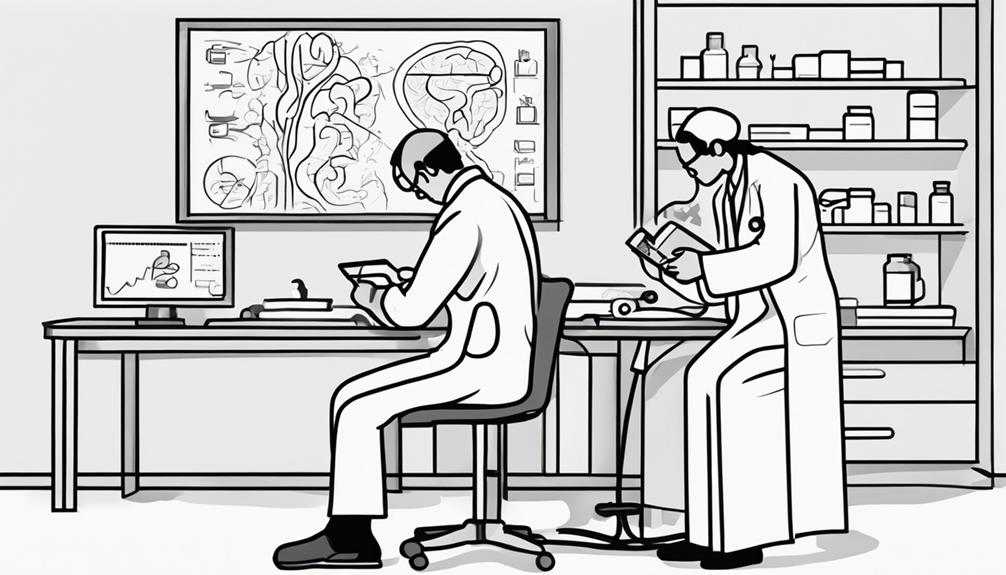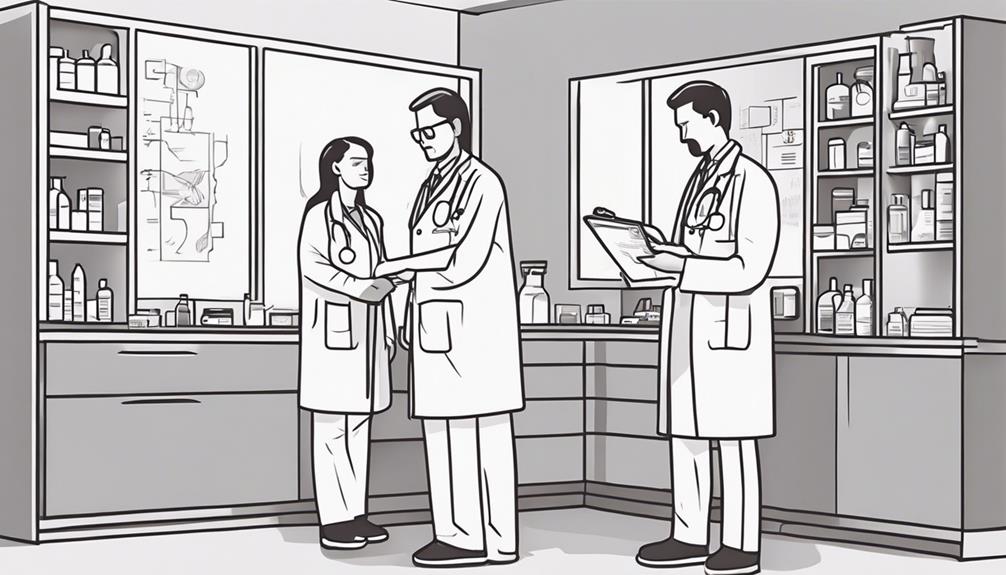Have you ever considered how crucial differential diagnosis is for Type 1 diabetes?
The significance of accurately distinguishing this condition from others goes beyond mere identification.
It plays a vital role in ensuring the appropriate treatment and management strategies are implemented for the well-being of those affected.
By understanding the complexities of differential diagnosis in Type 1 diabetes, you can grasp the critical impact it has on patient outcomes, making it a fundamental aspect of healthcare practice.
Key Takeaways
- Accurate differentiation ensures prompt insulin therapy initiation.
- Early detection aids in preventing severe complications.
- Meticulous monitoring of blood glucose levels guides tailored treatment.
- Proper diagnosis enhances long-term symptom management.
Importance of Differential Diagnosis

When evaluating a patient with suspected Type 1 diabetes, differentiating it from other similar conditions is crucial to ensure accurate diagnosis and appropriate management. Early detection and treatment are paramount in Type 1 diabetes to prevent complications. Prompt initiation of insulin therapy is vital to maintain blood glucose levels within a target range and prevent the development of diabetic ketoacidosis, a life-threatening condition characterized by high blood sugar and the presence of ketones in the blood.
Avoiding complications in Type 1 diabetes requires meticulous monitoring of blood glucose levels, adherence to insulin therapy, and regular follow-ups with healthcare providers. Untreated or poorly managed Type 1 diabetes can lead to serious complications such as cardiovascular disease, nerve damage, kidney failure, and vision problems. By differentiating Type 1 diabetes from other conditions early on, healthcare providers can tailor treatment plans to meet the individual needs of patients, ultimately improving their quality of life and reducing the risk of long-term complications.
Common Misdiagnoses in Type 1 Diabetes
Identifying common misdiagnoses in Type 1 diabetes is crucial for improving diagnostic accuracy and ensuring appropriate management strategies are implemented promptly. Misdiagnosis challenges often arise due to symptom overlap with other conditions, leading to delays in initiating proper treatment for Type 1 diabetes.
One common misdiagnosis is Type 2 diabetes, especially in adults initially presenting with hyperglycemia. This can occur because Type 2 diabetes is more prevalent and may be considered first, delaying the correct diagnosis of Type 1 diabetes, which requires insulin therapy.
Additionally, viral infections like gastroenteritis can mimic some early symptoms of Type 1 diabetes, such as increased thirst and urination, causing confusion in diagnosis. Another challenge is the misinterpretation of diabetic ketoacidosis (DKA) as a gastrointestinal issue, delaying the recognition of Type 1 diabetes.
Role of Symptoms in Differential Diagnosis

The differentiation of Type 1 diabetes from other conditions heavily relies on accurately interpreting the presenting symptoms. When assessing symptoms for a possible Type 1 diabetes diagnosis, several key points come into play:
- Polyuria and Polydipsia: Excessive urination and thirst are hallmark symptoms of Type 1 diabetes, often appearing suddenly.
- Unexplained Weight Loss: Rapid weight loss without changes in diet or activity level can indicate a serious underlying issue like Type 1 diabetes.
- Fatigue and Weakness: Feeling constantly tired and weak despite adequate rest can be a red flag for diabetes.
- Increased Hunger: Experiencing intense hunger even after eating could signal insulin deficiency typical of Type 1 diabetes.
- Blurred Vision: Sudden changes in vision clarity may result from high blood sugar levels associated with diabetes.
These symptoms, when considered alongside differential criteria specific to Type 1 diabetes, play a crucial role in accurately diagnosing the condition and differentiating it from other similar presentations.
Symptoms assessment forms the cornerstone of the diagnostic process, guiding healthcare providers towards timely and effective interventions.
Diagnostic Tests for Type 1 Diabetes
Diagnostic tests play a pivotal role in confirming the presence of Type 1 diabetes and guiding appropriate treatment strategies for individuals suspected of having the condition. Two primary tests used in the diagnosis of Type 1 diabetes are blood glucose levels and insulin levels.
Blood glucose levels are frequently measured to assess the amount of glucose present in the blood. In Type 1 diabetes, blood glucose levels are typically elevated due to the lack of insulin production by the pancreas. High blood glucose levels, known as hyperglycemia, are a hallmark feature of Type 1 diabetes.
Insulin levels are also measured to aid in the diagnosis of Type 1 diabetes. Individuals with Type 1 diabetes have low to undetectable levels of insulin in their blood due to autoimmune destruction of the insulin-producing beta cells in the pancreas. This distinguishes Type 1 diabetes from other types of diabetes where insulin levels may be normal or elevated. Accurate diagnosis through these tests is crucial for initiating the appropriate management of Type 1 diabetes.
Impact of Correct Diagnosis on Treatment

Correctly diagnosing Type 1 diabetes significantly influences the effectiveness of treatment strategies. The impact of a precise diagnosis on management and patient outcomes is profound. Here's why:
- Tailored Treatment Plans: Accurate diagnosis allows for personalized treatment plans, optimizing glycemic control.
- Prevention of Complications: Identifying Type 1 diabetes early helps prevent serious complications such as diabetic ketoacidosis.
- Improved Quality of Life: Proper diagnosis leads to better symptom management, enhancing the patient's overall quality of life.
- Enhanced Patient Education: Knowing the exact type of diabetes enables targeted education on self-care practices and lifestyle modifications.
- Long-Term Health Monitoring: A correct diagnosis ensures appropriate monitoring of long-term health indicators, aiding in proactive management strategies.
Frequently Asked Questions
Can Type 1 Diabetes Be Misdiagnosed as Type 2 Diabetes?
You need to be aware that Type 1 diabetes can be mistaken for Type 2. This misdiagnosis can lead to improper treatment choices, causing delays in insulin therapy initiation, and overlooking the essential lifestyle modifications needed for effective management.
What Are the Potential Complications of a Delayed or Incorrect Diagnosis of Type 1 Diabetes?
When a delayed or incorrect diagnosis of type 1 diabetes occurs, the potential consequences can lead to severe long-term complications. It is crucial to address this promptly to prevent further health issues.
Are There Specific Risk Factors That May Contribute to a Misdiagnosis of Type 1 Diabetes?
When considering diagnostic challenges in type 1 diabetes, specific risk factors, such as age and clinical manifestations, can contribute to misdiagnosis. Recognizing these factors is crucial for accurate identification and timely management.
How Can Healthcare Professionals Differentiate Between Type 1 Diabetes and Other Autoimmune Conditions During the Diagnostic Process?
As you navigate diagnostic challenges, consider immunological markers and clinical presentation. Look for differential factors like rapid onset and young age. Unravel the puzzle by carefully examining symptoms and lab results for accurate differentiation.
What Role Does Family History Play in the Differential Diagnosis of Type 1 Diabetes?
In pediatric cases, genetic predisposition from family history can complicate the differential diagnosis of type 1 diabetes. Early symptoms may overlap with other conditions, making accurate identification crucial for tailored treatment plans.
Conclusion
In conclusion, the importance of differential diagnosis in Type 1 diabetes can't be overstated. Accurate diagnosis is crucial to ensure proper treatment and management of the condition.
Common misdiagnoses can lead to delays in effective treatment, highlighting the necessity of thorough evaluation and diagnostic testing.
By correctly identifying Type 1 diabetes early on, healthcare providers can initiate appropriate interventions, ultimately improving patient outcomes and quality of life.
Always remember, accurate diagnosis saves lives.